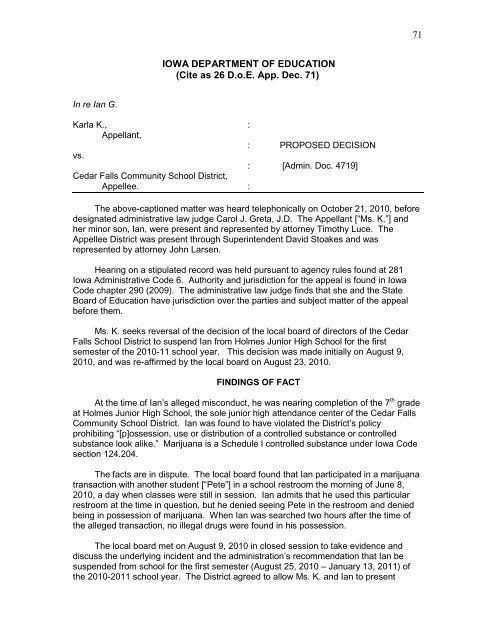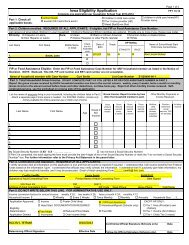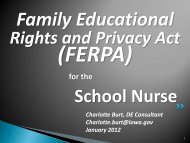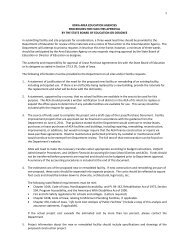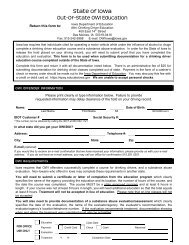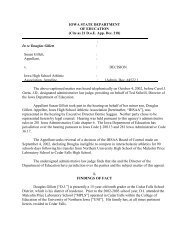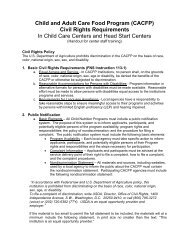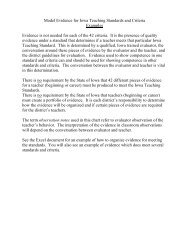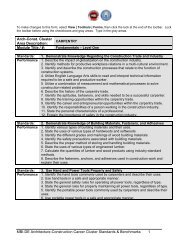Iowa Department of Education
Iowa Department of Education
Iowa Department of Education
You also want an ePaper? Increase the reach of your titles
YUMPU automatically turns print PDFs into web optimized ePapers that Google loves.
71IOWA DEPARTMENT OF EDUCATION(Cite as 26 D.o.E. App. Dec. 71)In re Ian G.Karla K., :Appellant,: PROPOSED DECISIONvs.: [Admin. Doc. 4719]Cedar Falls Community School District,Appellee. :The above-captioned matter was heard telephonically on October 21, 2010, beforedesignated administrative law judge Carol J. Greta, J.D. The Appellant [“Ms. K.”] andher minor son, Ian, were present and represented by attorney Timothy Luce. TheAppellee District was present through Superintendent David Stoakes and wasrepresented by attorney John Larsen.Hearing on a stipulated record was held pursuant to agency rules found at 281<strong>Iowa</strong> Administrative Code 6. Authority and jurisdiction for the appeal is found in <strong>Iowa</strong>Code chapter 290 (2009). The administrative law judge finds that she and the StateBoard <strong>of</strong> <strong>Education</strong> have jurisdiction over the parties and subject matter <strong>of</strong> the appealbefore them.Ms. K. seeks reversal <strong>of</strong> the decision <strong>of</strong> the local board <strong>of</strong> directors <strong>of</strong> the CedarFalls School District to suspend Ian from Holmes Junior High School for the firstsemester <strong>of</strong> the 2010-11 school year. This decision was made initially on August 9,2010, and was re-affirmed by the local board on August 23, 2010.FINDINGS OF FACTAt the time <strong>of</strong> Ian‟s alleged misconduct, he was nearing completion <strong>of</strong> the 7 th gradeat Holmes Junior High School, the sole junior high attendance center <strong>of</strong> the Cedar FallsCommunity School District. Ian was found to have violated the District‟s policyprohibiting “[p]ossession, use or distribution <strong>of</strong> a controlled substance or controlledsubstance look alike.” Marijuana is a Schedule I controlled substance under <strong>Iowa</strong> Codesection 124.204.The facts are in dispute. The local board found that Ian participated in a marijuanatransaction with another student [“Pete”] in a school restroom the morning <strong>of</strong> June 8,2010, a day when classes were still in session. Ian admits that he used this particularrestroom at the time in question, but he denied seeing Pete in the restroom and deniedbeing in possession <strong>of</strong> marijuana. When Ian was searched two hours after the time <strong>of</strong>the alleged transaction, no illegal drugs were found in his possession.The local board met on August 9, 2010 in closed session to take evidence anddiscuss the underlying incident and the administration‟s recommendation that Ian besuspended from school for the first semester (August 25, 2010 – January 13, 2011) <strong>of</strong>the 2010-2011 school year. The District agreed to allow Ms. K. and Ian to present
73action; the local board was not required to determine Ian‟s precise role in thetransaction. It was sufficient that the board found Ian to be a party in the transactionbecause any participation in the transaction required Ian to be in possession <strong>of</strong> the drugat some point.It is the factfinder‟s duty to weigh credibility. See <strong>Iowa</strong> Supreme Court AttorneyDisciplinary Board v. Weaver, 750 N.W.2d 71 (<strong>Iowa</strong> 2008). “It is entirely reasonable togive credibility to the students who admitted their own guilt and implicated the Perrys… .”In re Perry, 22 D.o.E. App. Dec. 175, 181 (2003). There is no evidence that Pete had amotive to lie either about his own guilt or about Ian‟s involvement.This is not a criminal proceeding; accordingly, the local board also had the right todraw an inference from Ian‟s lack <strong>of</strong> presentation <strong>of</strong> corroborating evidence <strong>of</strong> hisdenials. Ian‟s explanation that he failed to present corroboration because he would notbe believed does not ring true, particularly given that a full semester <strong>of</strong> his education atthe District was at stake.One <strong>of</strong> the points made by Ms. K. is that the District‟s administrators and somestudents are “predisposed” to conclude that Ian is involved in illegal drug use orpossession. To the extent that this is true, it appears that any such predisposition wasnot created in a vacuum. Ian has cultivated and portrayed to his peers an image <strong>of</strong>himself as a participant in the drug culture.Nor can this Board conclude that Principal Welter personally was predisposed tobelieve that Ian was culpable in this incident. Prior to the events <strong>of</strong> June 8, PrincipalWelter had received reports or concerns about Ian from various sources. The principaldid not initiate or create any <strong>of</strong> the situations involving Ian. He merely investigated themas is his duty to do so. These are summarized as follows:On April 1, another student told one <strong>of</strong> the school‟s counselors that Ian tooka pill out <strong>of</strong> his wallet at lunch and said it was a drug. It is likely that thiswas a candy “dot” and not a pharmaceutical. However, this incident showsthat Ian appears to want to present himself as “doing drugs.”On April 2, more than one student reported to the principal‟s <strong>of</strong>ficesuspicious behavior at Ian‟s locker, and an anonymous parent called tostate that Ian had told other students that he was doing crack cocaine.There is no evidence that any wrongdoing took place at Ian‟s locker, andwe accept his mother‟s assertion that Ian was repaying a loan, whichaccounts for open wallets at his locker. Also, there is no evidence that Ianwas a user <strong>of</strong> crack cocaine. However, again this incident shows that, forwhatever reason, Ian wanted to be known as a participant in the local drugculture.On April 19, a sixth grader in another attendance center <strong>of</strong> the District toldthe principal <strong>of</strong> that building that there are drugs at Ian‟s home and that Ianwas saying that he has access to weapons. Ms.K. states that Ian has twoAirs<strong>of</strong>t BB guns, but denies the presence <strong>of</strong> drugs at the residence.
74Finally, on June 4, Ian was sitting in class and decided to transfer six bills(folding money) from one pocket to the other in a conspicuous enoughmanner to attract the attention <strong>of</strong> the teacher. The teacher reported Ianhaving a “bunch <strong>of</strong> money” and suggested to Ian that he have the school‟sbookkeeper keep it until day‟s end.This case is not factually dissimilar to the appeal, In re Hodges, 22 D.o.E. App.Dec. 279, 283 (2004). In that case, this Board upheld the local board‟s expulsion <strong>of</strong> astudent for possession <strong>of</strong> a Schedule II controlled substance (oxycodone) at schoolwhen the only direct evidence was the statement <strong>of</strong> a fellow student.The only direct evidence that the pills Zach bought and ingestedone <strong>of</strong> were a Schedule II controlled substance was the statement<strong>of</strong> Student A. Student A told school and law enforcementauthorities that the pills he sold to Zach came from a group <strong>of</strong> pillshe had purchased from Student B, the remainder <strong>of</strong> which herelinquished to the District and one <strong>of</strong> which was tested by the DCIand identified as oxycodone.No testing could be conducted <strong>of</strong> the two pills purchased by Zach.He claims to have swallowed one and lost the other. No testing <strong>of</strong>Zach‟s blood or urine was requested <strong>of</strong> or volunteered by Zach.Zach did not show any outward signs to his principal <strong>of</strong> beingunder the influence <strong>of</strong> a drug. ...But, direct evidence is not required. Even in a criminal case,where the standard <strong>of</strong> pro<strong>of</strong> is “beyond a reasonable doubt” (asopposed to the “preponderance <strong>of</strong> the evidence” standard in localboard hearings), direct and circumstantial evidence are equallyprobative. E.g., State v. Schmidt, 588 N.W.2d 416, 418 (<strong>Iowa</strong>1998). “An inference <strong>of</strong> knowledge and intent can be drawn fromthe circumstances.” In re Amy Cline, 2 D.P.I. App. Dec. 16, 19(1979).In re Hodges, 22 D.o.E. App. Dec. at 283.The local board met at great length to review all <strong>of</strong> the evidence presented to it,and agreed to permit Ms. K. and Ian to present additional evidence prior to its finaldeliberations. By no means did the local board merely rubber-stamp the administration‟spunishment recommendation. We have no basis upon which to overturn its decision.DECISIONFor the foregoing reasons, it is recommended that the decision <strong>of</strong> the Board <strong>of</strong>Directors <strong>of</strong> the Cedar Falls Community School District made on August 9, 2010 andreaffirmed by that board on August 23, 2010, suspending Ian from the District for the firstsemester <strong>of</strong> the 2010-2011 school year be AFFIRMED. There are no costs <strong>of</strong> thisappeal to be assigned.
75__11/17/10________Date__/s/ _____________________________Carol J. Greta, J.D.Administrative Law JudgeIt is so ordered.________________Date__________________________________Rosie Hussey, PresidentState Board <strong>of</strong> <strong>Education</strong>


